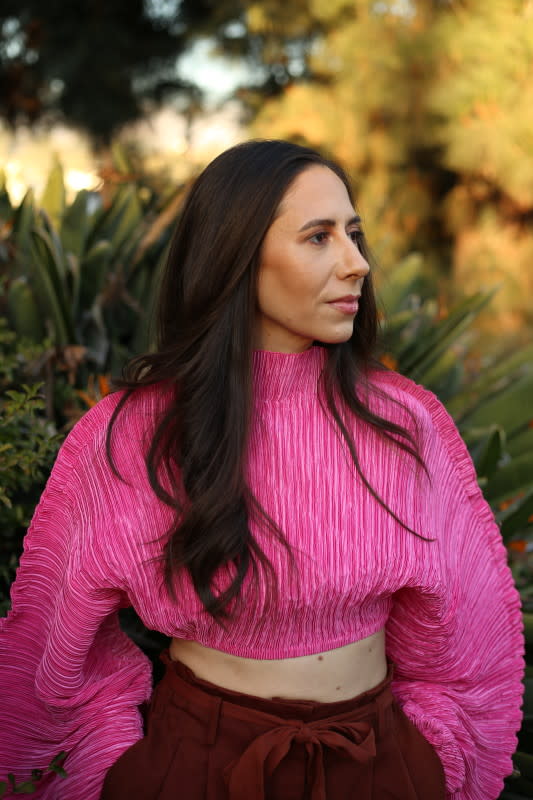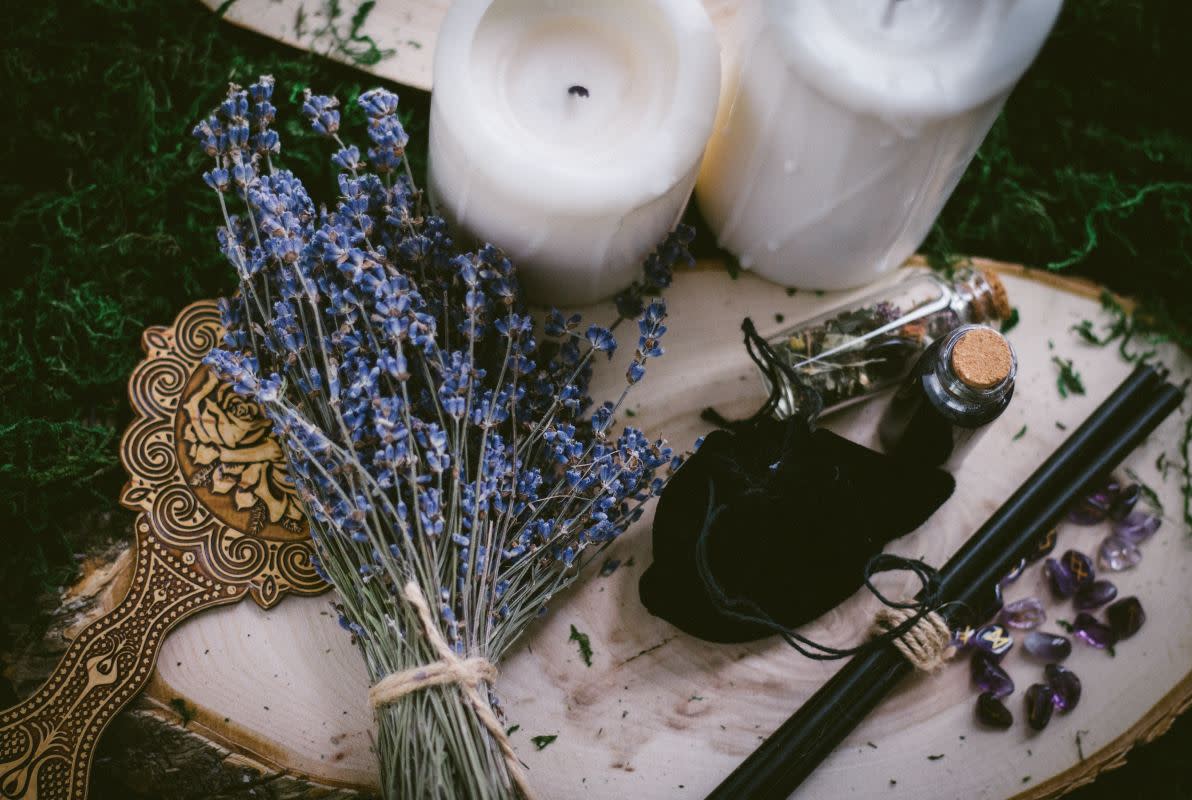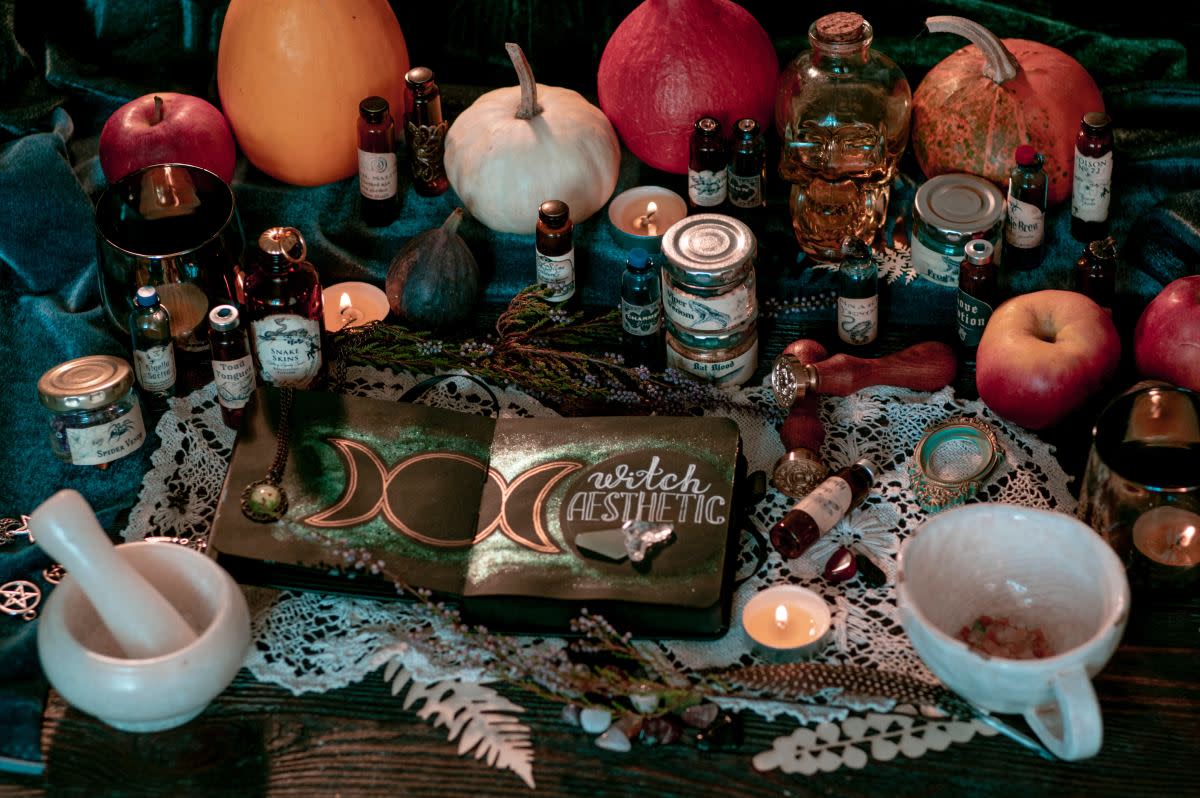What Everyone Gets Wrong About Witches, According to a Modern-Day Witch Herself

Depiction of a witch
When you hear the word “witch,” there are undoubtedly many specific images that come to mind. Do you see a woman in a long cloak and witch's hat, brewing a hot potion in her cauldron? Do you think of the Sanderson Sisters from Hocus Pocus and their flashy “I Put a Spell on You” musical number? Do you see the more horrific depictions of witches on TV—like in American Horror Story: Coven—or in movies, like A24’s 2015 movie The WITCH? Witches—whether urban legends or historical figures—have turned into such pop culture staples that popular tropes and visual portrayals of them are some of the most recognizable images we have. And with that comes a lot of common myths and misconceptions about witches.
Sarah Faith Gottesdiener is a modern-day witch—and business owner, podcaster and teacher, among other things—and does not fit any of those witchy tropes at all. Much like those “Stars! They’re just like us!” tabloid magazine spreads that show celebrities at Trader Joe’s or putting gas in their cars, witches are just like us too. Gottesdiener notes that she pays bills, goes to the grocery store and does “normal” things that you might not associate with witches.
“With witchcraft, there's a saying that the magic is in the mundane and the magic is in the everyday and it's how we live our lives,” Gottesdiener tells Parade. But where do all of those misconceptions about witches come from? And what does everyone get wrong about modern-day witches and witchcraft?
The history of witchcraft and the prosecution of witches (whether they were real witches or not) is long and complicated. But with Gottesdiener’s help, we’re debunking seven myths and misconceptions about witches (and hopefully teaching you a thing or two while we’re at it).
Related: 24 Best Things To Do in Salem, Massachusetts
7 Things Everyone Gets Wrong About Witches, According to a Modern Witch
1. "Witches do spells on other people and use magic to control you."

Courtesy of Sarah Faith Gottesdiener
We already mentioned Hocus Pocus, but in that movie lies the first big misconception people have about real witches: that they do spells on other people—typically for personal gain. That’s definitely not the truth, at least not for Gottesdiener. She notes that in her protection magic classes, she uses a quote she found on X (formerly Twitter): “Spiritual people don't hate you, they nothing you.” She also does a lot of energy work in her practice and that includes shielding your own energy and protecting it. Therefore expelling energy on other people—especially for a negative cause—is not something she’d do.
“The biggest [misconception] that pops up is that witches are doing spell craft on other people or on you. That they're collecting your hair or there's… all this malevolent magic,” Gottesdiener says. “And I'm just like, why would I ever want to waste my energy? If we're thinking about everything is energy. Why would I wanna waste my energy, meddling in someone else's life? I don't even know you.”
Something that goes hand-in-hand with this misconception that witches are out here hexing and putting spells on unsuspecting mortals is the myth that they try to make men fall madly in love with them with love spells or potions. It’s a trope for sure, but also doesn’t jive with Gottesdiener’s mindset (and most modern witches). If we live in a free-will world, why would you want a relationship that’s fake and not authentic? “That’s cuckoo pants,” she tells Parade.
She does note, though, that witches are, in fact, human. And just as there are good humans and bad humans—and mentally unwell humans—there are witches that, sure, might do bad things with their practice. But on the whole, witchcraft teaches a spirituality that’s about bettering yourself and the world. So causing harm to someone else by either taking away their free will or cursing them is not what most witches set out to do.
Related: Time To Make Magic—We Have 31 DIY Witch Costume Ideas To Get Your Creativity Boiling
2. “Witches are not smart.”
There’s this idea that witches are pretty woo-woo people, only interested in what their crystals have to say, only living by angel numbers they see or are irrationally superstitious. Gottesdiener says that there’s this idea that you’re a “bimbo” who doesn’t believe in science or knows history if you’re a spiritual person into witchcraft. However, that’s not the case for modern witches.
“I'm smart. I read philosophy books,” Gottesdiener says. “I listen to science podcasts, I’m obsessed with neuroscience and I have thought about going back to school for neuroscience.”
Again, witches, they’re just like us, right? So if you meet or know a modern-day witch, they’re also living in the 21st century. They aren’t idiots, stupid or gullible just for having a different belief system than you.
3. "Witches have to look a certain way or you have to give into the commodification of witchcraft to be an actual witch."
There is a very specific image that the word “witch” conjures up in your head; as we already stated, you might imagine Elphaba from Wicked, with her black, modest dresses and pointy hat that Glinda gave her. That "pointy hat, broomstick and cauldron" witch aesthetic isn’t really what modern-day witches walking amongst us in Target look like.
Gottesdiener notes that this belief that “you can’t just be a human in some jeans and some clogs” feeds into this notion that witches aren’t “regular people,” which they are.
And on top of this idea that you have to have a certain look to be a witch is this misconception that you also have to feed into the growing commodification of witchcraft.
“The way that we see it with the rise of social media is very much like an aesthetic,” Gottesdiener tells Parade. “[There’s an idea that] you can't be a spiritual person or a practicing witchcraft without $9,000 worth of crystals.”
So, no, you don’t have to look a certain way to be a practicing witch, and you don’t have to give in to fad shops and own thousands of dollars worth of spell-casting ingredients or tools. Witchcraft is very personal and modern-day witches can use kitchen items, household tools or whatever they please to start practicing.
4. "Witches were targeted because they were evil or bad."

Unsplash
If you know the real history of the Salem Witch Trials, then you’d know that they weren’t really about dispelling the towns of Salem and Danvers, MA of evil witches. It was more complicated than that and didn’t even involve killing real witches; all of the people who were executed for “witchcraft” were innocent, per the Boston Public Library. And that’s kind of the general history of most witch trials in Europe and the United States.
Gottesdiener—who also hosts the popular Moonbeaming podcast, which is “for the modern witch and magical critical thinker”—pointed out that a lot of the people accused of witchcraft through history were really just scapegoats people wanted to throw under the bus.
They were often women, unmarried women or unmarried women who owned property or brought in their own income (a big no-no back then). Basically, if you were “outside of normal heterosexual, white, Christian patriarchal” structure of society, you were a target. Being an actual witch was irrelevant to the accusations thrown around at the time. People accused of witchcraft were just “trapped in the crosshairs of someone else,” as Gottesdiener says. But what better way to convince others that someone is evil than accusing them of being a witch?
“We know that witchcraft can't be seen in mainstream society as something that's positive and healing and connective and caretaking—which it 1000% is for me,” she says. “It has to be seen as evil, which is to be seen as unloved, ugly.”
5. "Witchcraft and magic are just inherently evil."
On top of the fact that the history of the prosecution of “witches” often didn’t include actual witches on trial, colonialism did lead to the demonization of indigenous practices. Anything that wasn’t Christian, white or “civilized” was deemed as bad or wrong and not “of God.” These practices were seen as taboo or evil, but they were native people’s belief systems and their way of explaining things around them and finding remedies at a time when those answers weren’t known—even to colonizers.
“A lot of magic is indigenous because a lot of magic is about survival. We need to survive,” she says. “A lot of folk magic is around money, around health, around protection because we need to survive because that's life. I mean, life is really hard now and life was really hard hundreds of years ago.”
Interestingly, indigenous practices that were once deemed as evil back when settlers came into new lands like India, Mexico and more, are now coopted as “New Age” practices.
Gottesdiener points to Yoga Nidra, somatics and more, which are “witchcraft practices,” but also are “in” and “hip” because venture capitalists or white people are into them now. While traditions like these were shunned hundreds of years ago—with native people not allowed to practice their own religions—they’re widely accepted now because of Westernized acceptance or even “discovery” of said practices.
“These are indigenous spiritual shamanic practices that have been practiced all over the globe,” Gottesdiener tells Parade. “And now just because some white dude who has a degree from Stanford or something can repackage it and rebrand it and call it a different name, people are benefiting from it. But these practices and traditions have been in place for literal thousands of years and they've been in place for literal thousands of years because they're effective and because they work.”
6. "Witchcraft is all potions, incantations and caldrons."

Unsplash
While modern-day witches can do spells, use herbs and incense and use incantations in their practices, that’s not all witchcraft is. Gottesdiener teaches classes on protection magic, money alchemy and more, but she also does a lot of energy work including one-on-ones on how to integrate spirituality into your life. This aspect of spirituality is all about teaching others what she wishes she’d “learned in school.” This includes lessons on boundaries, abundance, creativity, intuition and, again, energy work. She used a lot of words that you might hear your therapist use as well, like grounding yourself and learning how to “emotionally regulate” your nervous system.
“A lot of us are carrying… a lot of us were raised to carry our energy and set up our energetic field in such a way—especially for folks who are creative, artistic, highly sensitive, highly attuned, especially for folks who have a background of trauma— we were taught to be like the emotional processor,” Gottesdiener explains. “We were taught to be much more highly attuned to what was happening externally and kind of just like living in reaction to, but not responding. Or not understanding what was going on in our energy.”
She teaches people the basics of how to call “your energy back” and “calling your power back.” This includes navigating past trauma and your own feelings, such as finding out if your emotional outburst is because of a childhood wound you need to heal. She explains that a lot of people are “like a sponge” with other people’s tense or negative emotions, so she teaches people how to protect their energy and not absorb these intense, outsider emotions and energies.
7. "Witches serve the devil."
Lastly—and we’ve already mentioned this a bit—but just like witchcraft isn’t inherently evil or doesn’t directly conflict with mainstream religions if you don’t want it to, witches don’t serve the devil. While Gottesdiener loves the movie The WITCH, there is no book you sign for Satan to become a witch.
Witchcraft is often feared or depicted in this way because it is so different from the power structure and worship systems set in place by Christianity and a lot of monotheistic religions. Gottesdiener stresses that there is no shame in witchcraft and a lot of it is about empowering yourself and taking control of your life. She explains that with something like Christianity, there is a lot of control and power taken away in favor of a higher power that’s in charge of everything—even your afterlife.
“There’s always a paradox. There’s a paradox between control and power, where we almost have to surrender and be in flow in order to step into our agency,” she says. “And we live in a culture that is very afraid of power and control while simultaneously craving it more than anything.”
For Gottesdiener, spirituality saved her life and healed her in ways that other things weren’t able to. It’s been a way to hone in on her natural gifts, find herself and listen to her intuition. Being a witch and carving out this spirituality for herself helped her find trust in the universe and the earth, and in doing so find trust in herself again. Because, after all, as Gottesdiener says, “witchcraft is a permission slip.”
Next up, if you did really love Hocus Pocus growing up, these are the seven real-life locations to visit in Salem, MA.
Source:
Sarah Faith Gottesdiener is the host of the Moonbeaming podcast and owner of The Moon Studio, a mystic shop and a venue to learn more about spirituality, creativity and witchcraft. Gottesdiener is @gottesss on Instagram and the author of, The Moon Book: Lunar Magic to Change Your Life.
